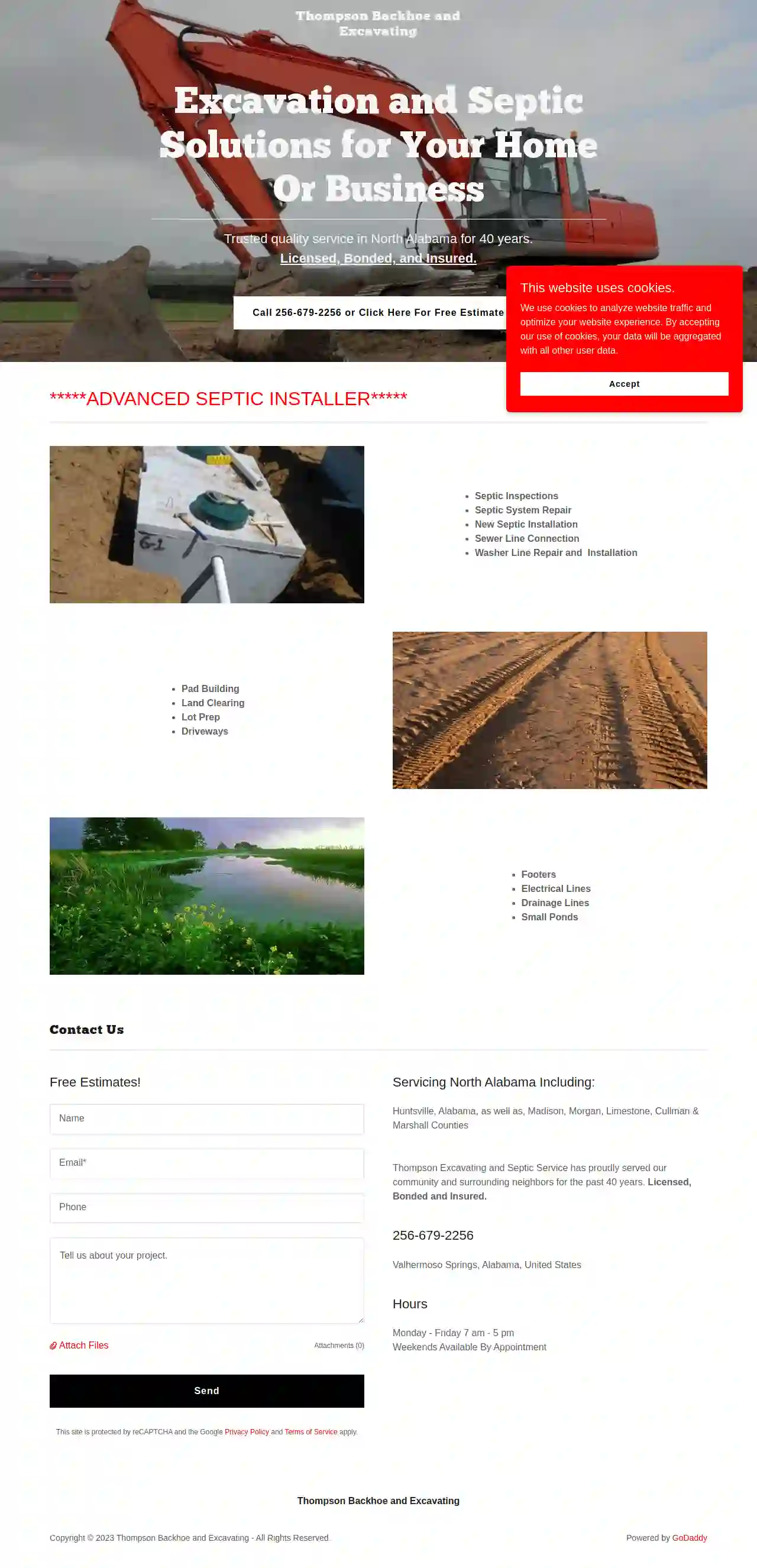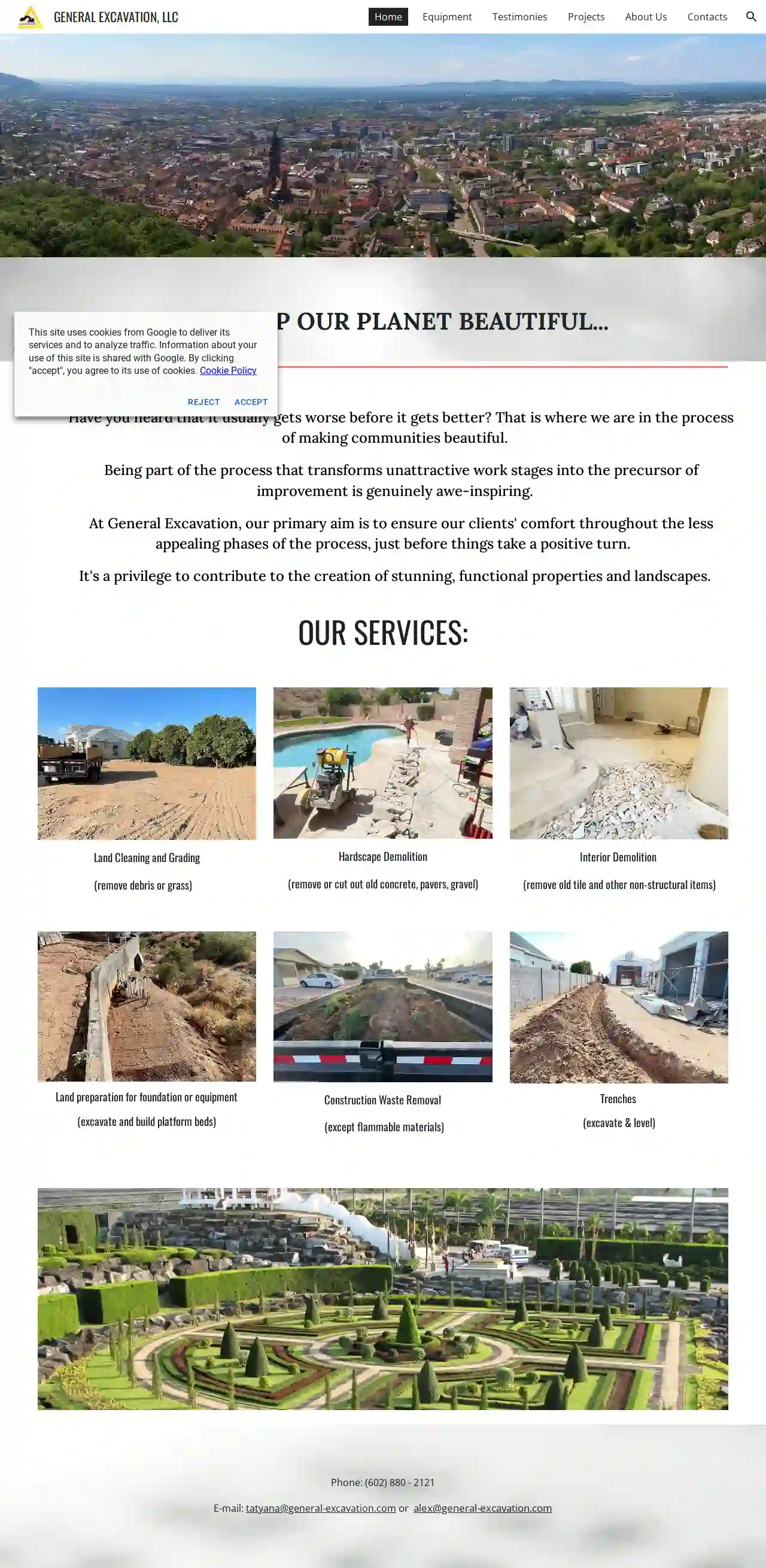Excavation Contractors Cullman
Top Excavation Company Near Me in Cullman
Receive up to 3 Land Excavation quotes for your project today! Compare profiles, reviews, accreditations, portfolio, etc... and choose the best deal.

Godwin Land Solutions
552 reviewsHuntsville, USThank you in advance for choosing Godwin Land Solutions LLC for your next project. GLS is family owned and operated in Mobile County, Baldwin County and surrounding areas. The GLS team is a certified and experienced LLC. We are competent in our work to make sure the job is done correctly and completed in a timely manner. At GLS we strive for customer satisfaction and a quality result at the end of each project. Godwin Land Solutions is Licensed and Insured. We offer a large variety of Commercial and Residential Land Development & Site Preparation Services.
- Services
- Why Us?
- Gallery
Get Quote
SK Excavating LLC
59 reviews161 Granada Lane, Guntersville, 35976, USSince 2015, SK Excavating LLC has been serving Guntersville, Alabama, and the surrounding area with professional-quality excavation and demolition services. We are a family-owned and operated business dedicated to providing every client with affordable service perfectly tailored to their needs. We offer a variety of excavation and demolition services ranging from land clearing to structural demolition. We welcome the opportunity to gain your trust to handle all of your excavation and demolition needs now and in the future. Our mission is to provide all clients with excavation and demolition solutions that will surpass their expectations. We treat every project with care and professionalism and strive to provide professional, timely, and affordable services. We are committed to building lasting relationships within the community and handling all of your excavation and demolition needs now and in the future.
- Services
- Why Us?
- Our Team
- Gallery
Get Quote
North Alabama Land Services
54 reviews11002 Vivian Drive NW, Huntsville, 35810, USNorth Alabama Land Services is here to help you! We are a family-owned and operated business with rock solid values that stand for honesty, integrity, and hard work. We know that your property is important to you, so it is important to us too. Therefore, we are not finished until you are satisfied. We look forward to meeting you, and getting to work on your next project. Please contact us to schedule your in person appointment for a free estimate. Your land, our expertise, endless possibilities. Unleash your land's potential with North Alabama Land Services.
- Services
- Why Us?
- Our Team
- Gallery
Get Quote
Thompson Backhoe & Excavating
4.58 reviewsValhermoso Springs, USExcavation and Septic Solutions for Your Home Or Business Trusted quality service in North Alabama for 40 years. Licensed, Bonded, and Insured. Call 256-679-2256 or Click Here For Free Estimate
- Services
- Why Us?
- Gallery
Get Quote
Bama Dirt Bulk Yard Madison
4.662 reviewsP.O. Box 36, Anderson, 35610, USAbout Bama Dirt: North Alabama Aggregate Supply & Services We provide aggregate materials and services for residential markets of North Alabama. From small to large aggregate projects, we fulfill each order to meet customer specifications. We take pride in differentiating ourselves from other aggregate providers by providing exceptional customer service and quality, and we're commited to building solid, successful relationships with our customers. Based in Killen, Alabama, we serve all areas of North Alabama surrounding Florence, Muscle Shoals, Athens, Madison, Huntsville, Decatur, Cullman, Moulton, Hartselle, Sheffield and more. We travel as far west as the Mississippi line, and also serve areas of Southern Tennessee. If you have a question about whether we'll come to you, give us a call at 256-740-7406 or send us a quick message to learn more. Our quality aggregate materials have been used in a variety of residential landscaping projects throughout North Alabama and Southern Tennessee. Bama Dirt aggreates are commonly used for building or repairing driveways, ditch construction, erosion control, embankments, backfill, and other landscaping needs.We strive to maintain the highest quality and service possible by following the customer’s guidelines to guarantee our aggregates have met all project specifications. If you have a project you would like to discuss with us, call (256) 740-7406 or send us a few details for a free estimate or site evaluation. Bama Dirt has trained and experienced professionals that understand how to operate in the most delicate areas. With our committed workforce and our line of heavy duty equipment, Bama Dirt provides a full range of landscaping services to residential homeowners of North Alabama. Our services are utilized for land clearing for a small residential lot to driveway repair, culvert installation, French drains, sod installation, and much more. If you would like to learn more about our services, call us today at (256) 740-7406 to speak with a professional about your resdiential project. We provide free estimates and site evaluations throughout North Alabama.
- Services
- Why Us?
- Our Team
- Gallery
Get Quote
Land & Lawn Development Services
Huntsville, USSitework and Land Development Done Right Land & Lawn Development Services, LLC is committed to providing high-quality, affordable sitework and land development services. We have the equipment, experience, and expertise to get your job completed correctly. When you're tired of doing a job twice, call us and let us provide you with a free quote. We are accredited by the Better Business Bureau, so you can be confident that you're working with a reputable company.
- Services
- Why Us?
- Accreditations
- Gallery
Get Quote
Roto-Rooter Plumbing and Water Cleanup
4.8Huntsville, USYour Local Roto-Rooter Plumber in Huntsville, AL Roto-Rooter delivers expert plumbing solutions in Huntsville, Alabama, that you can count on 24/7/365. Whether you’re struggling with sewer lines, water damage, or drain cleaning, our skilled plumbers are ready to tackle any plumbing challenge, large or small. Since 1935, Roto-Rooter has stood apart from the pack as Huntsville’s premier provider of drain cleaning and plumbing services. Our commitment to quality and customer satisfaction means that when you choose Roto-Rooter, you get: Same day service 24/7 availability Highly trained, experienced plumbers State-of-the-art diagnostics and equipment No hidden or extra charges for plumbing or drain service on holidays, nights, and weekends Free onsite and upfront estimates Fully licensed, insured, experienced plumbers Senior and military discounts Special financing options available Schedule your appointment with our Huntsville plumbing experts via our online form, or call our 24/7/365 service line at 256-533-7246. Comprehensive Plumbing Solutions in Huntsville, AL No matter what plumbing problem you’re facing, Roto-Rooter has the expertise and experience to get the job done right. We offer a wide range of plumbing services, including:
- Services
- Why Us?
- Testimonials
- Gallery
Get Quote
General Excavation, LLC
55 reviewsMadison, USGeneral Excavation: Transforming Landscapes, One Project at a Time General Excavation is a dedicated team committed to enhancing communities through meticulous landscaping and excavation services. We understand that the process of transforming a space can be challenging, and we strive to make it as smooth and comfortable as possible for our clients. Our passion lies in taking on the less appealing phases of a project, ensuring that the foundation for a stunning and functional outcome is laid with precision and care. We are proud to contribute to the creation of beautiful and practical properties and landscapes, leaving a lasting positive impact on the communities we serve.
- Services
- Why Us?
- Gallery
Get Quote
On Time Excavation and Tractor Services
111 Walkers Hill Rd Meridianville, AL, Meridianville, 35759, USOn Time Excavation and Tractor Services On Time Excavation and Tractor Services is a local business dedicated to providing high-quality excavation and tractor services to the Huntsville, Alabama area. We are committed to delivering exceptional service and exceeding our clients' expectations. Our team of experienced operators is equipped with a wide range of equipment, including excavators, tractors, and various attachments, to handle any project, big or small. We understand the importance of efficiency and reliability, and we strive to complete every job on time and within budget. Whether you need help with site preparation, landscaping, demolition, or any other excavation or tractor-related task, On Time Excavation and Tractor Services is your trusted partner. We are passionate about our work and take pride in delivering exceptional results. Contact us today for a free consultation and let us help you bring your project to life.
- Services
- Why Us?
- Gallery
Get Quote
Triple J Land Services - Dirt Works
3.45 reviews407 Pinedale Road, Huntsville, 77320, USTriple J Land Services: Your Trusted Dirt Works & Excavation Contractor in Huntsville, TX Looking for a reliable and experienced excavation contractor in Huntsville, TX? Look no further than Triple J Land Services! We've been serving the greater Huntsville area, including Madisonville, The Woodlands, Livingston, and College Station, for years, providing top-notch service and expertise for all your excavation needs. We understand that your property is valuable, and we treat every project with the utmost care and attention to detail. Whether you need land clearing, pond construction, grading, or site preparation, our team has the skills and equipment to handle any job, big or small. We're committed to providing our clients with the highest quality service at competitive prices. We're also dedicated to working closely with you to ensure your project meets your specific needs and budget. Contact us today for a free estimate and let us help you transform your property into something truly special!
- Services
- Why Us?
- Testimonials
- Gallery
Get Quote
Over 22,076+ Excavation Pros on our platform
Our excavation contractors operate in Cullman & surrounding areas!
ExcavationHQ has curated and vetted the Best Excavation Pros in and around Cullman. Find a reliable pro today.
Frequently Asked Questions About Excavation Contractors
- Spring and Fall: Often considered favorable due to moderate temperatures and drier soil conditions.
- Summer: Can be suitable, but hot weather can make working conditions challenging and might require additional measures (shade, hydration) for workers.
- Winter: Excavation in winter can be more difficult due to frozen ground, snow, and potential delays caused by inclement weather. It might also require specialized equipment or techniques.
- Experience: Choose contractors with a proven track record and years of experience in excavation projects similar to yours.
- Licensing and Insurance: Verify that they are properly licensed to operate in your area and carry adequate insurance to protect you from liability in case of accidents or damage.
- Equipment and Resources: Ensure they have the necessary equipment and resources to handle your project efficiently and safely.
- Positive Reviews and References: Check online reviews and testimonials from previous customers. Request references and contact them to inquire about their experience with the contractor.
- Professionalism: Opt for a company that communicates clearly, provides detailed and transparent estimates, and has a responsive and courteous team.
- Trench Collapses: Unstable trench walls can cave in, posing a severe risk to workers. Proper shoring and sloping are crucial safety measures.
- Utility Damage: Striking underground utilities (gas, water, electric) can cause leaks, explosions, or electrocution. Accurate utility locates and careful digging are essential.
- Falling Objects: Materials or equipment falling into excavations can injure workers. Securing work areas and using appropriate safety gear is vital.
- Equipment Accidents: Operating heavy machinery involves risks of rollovers, collisions, or mechanical failures. Trained operators and proper equipment maintenance are critical.
- Environmental Hazards: Excavated soil might contain hazardous materials (asbestos, lead). Proper testing and disposal procedures are necessary.
- New Construction: Laying foundations, basements, or underground utilities for new buildings.
- Home Additions: Creating space for new rooms, basements, or extensions.
- Landscaping: Leveling ground, creating slopes, installing retaining walls, or digging for ponds or pools.
- Drainage Improvement: Installing French drains, drainage ditches, or swales to manage water runoff.
- Utility Installation or Repair: Laying new water, sewer, gas, or electrical lines, or repairing existing ones.
- Demolition: Clearing debris and preparing the site after demolishing a structure.
What is the best time of year for excavation?
How do I find a good excavation contractor?
What are the risks associated with excavation?
How do I know if I need excavation for my project?
What is the best time of year for excavation?
- Spring and Fall: Often considered favorable due to moderate temperatures and drier soil conditions.
- Summer: Can be suitable, but hot weather can make working conditions challenging and might require additional measures (shade, hydration) for workers.
- Winter: Excavation in winter can be more difficult due to frozen ground, snow, and potential delays caused by inclement weather. It might also require specialized equipment or techniques.
How do I find a good excavation contractor?
- Experience: Choose contractors with a proven track record and years of experience in excavation projects similar to yours.
- Licensing and Insurance: Verify that they are properly licensed to operate in your area and carry adequate insurance to protect you from liability in case of accidents or damage.
- Equipment and Resources: Ensure they have the necessary equipment and resources to handle your project efficiently and safely.
- Positive Reviews and References: Check online reviews and testimonials from previous customers. Request references and contact them to inquire about their experience with the contractor.
- Professionalism: Opt for a company that communicates clearly, provides detailed and transparent estimates, and has a responsive and courteous team.
What are the risks associated with excavation?
- Trench Collapses: Unstable trench walls can cave in, posing a severe risk to workers. Proper shoring and sloping are crucial safety measures.
- Utility Damage: Striking underground utilities (gas, water, electric) can cause leaks, explosions, or electrocution. Accurate utility locates and careful digging are essential.
- Falling Objects: Materials or equipment falling into excavations can injure workers. Securing work areas and using appropriate safety gear is vital.
- Equipment Accidents: Operating heavy machinery involves risks of rollovers, collisions, or mechanical failures. Trained operators and proper equipment maintenance are critical.
- Environmental Hazards: Excavated soil might contain hazardous materials (asbestos, lead). Proper testing and disposal procedures are necessary.
How do I know if I need excavation for my project?
- New Construction: Laying foundations, basements, or underground utilities for new buildings.
- Home Additions: Creating space for new rooms, basements, or extensions.
- Landscaping: Leveling ground, creating slopes, installing retaining walls, or digging for ponds or pools.
- Drainage Improvement: Installing French drains, drainage ditches, or swales to manage water runoff.
- Utility Installation or Repair: Laying new water, sewer, gas, or electrical lines, or repairing existing ones.
- Demolition: Clearing debris and preparing the site after demolishing a structure.